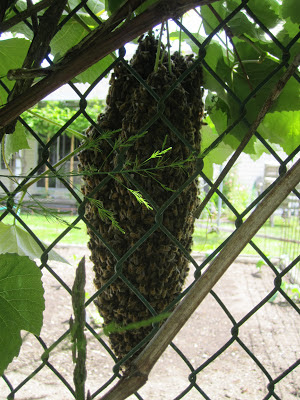I was away on a family matter, and upon returning to see what 2 weeks of rain and sun (and tending by my helpful husband) had done for the garden plantings, was welcomed by blooming flowers and lush vegetation in the perennial beds.
One of our many clematis plants, which will bloom a second time in the fall if the weather is right.
An established clump of delphinium, going on four summers now - the tallest reaches over 8 feet.
The main perennial flower and herb bed, backed with honeysuckle (middle), an early clematis on one end, and an evergreen clematis at the far end, which smells heavenly in the spring covered in small white flowers. Hollyhock, Columbine, Lily, Calendula, and several other flowers will soon add bursts of colour. Purple Coneflower and Black-Eyed Susans will come out for a bright show in the fall. Everything is popping up through a living mulch of alpine strawberry and very prolific oregano. Please ignore the chicken wire - it's there for a very good reason!
In the vegetable garden, not much had changed, though a few seeds had sprouted, the kidney and soy beans were up, and the only casualties of pests were some of my optimistically planted winter squash. Vine borers are less interested in my summer squash plants, but seem to find my winter squash transplants no matter how I try to hide them among herbs and flowers.
There are still some promising squash candidates in the tomato hoop house, but I won't get too excited until they size up a bit and are looking more vigorous.
The garlic is starting to produce scapes, and the shallots were sending up flower stalks, which were cut down at the base per my internet information search. The very tips of the leaves are drying up, so they may be ready for harvesting ahead of the garlic.
The next order of business was to open up the hive and do a full inspection, having seen odd comb building and drone brood before I left, I was curious what we would find.....
There was some minor attachment to the sides of the hive, and some continued irregular building, but with much less crossover than before, meaning less damage upon prying the bars apart.
Then Adrian noticed what I had been assuming we might find...
These large, irregular, downward-facing cells appear to be queen cells. There are some drone cells present on the periphery of the brood chamber (and visible in the bottom picture, with the slightly rounded covers- not flush with the comb as in a worker cell), as well as a notable number of drones wandering about in the hive. We still have not been able to visually identify our queen, but it does look like there has been a reduction in egg laying, and a portion of the brood chamber is vacant, though well-maintained. I'm not sure if the queen that came with our package is being replaced due to some change in behavior that the colony has been alerted to, or if this is simply a seasonal swarm preparation. We may simply have opened the hive right after a large number of bees emerged. We made sure there were several new bars added to expand space, so we don't believe that they are feeling crowded.
This is a all a new experience for us, and my research tells me that the colony knows what it needs - we'll have to wait and see what the next few weeks brings, and perhaps try to build or purchase a second hive to home the swarm (which should include the original queen). Our current top bar hive can be temporarily used to house a swarm with a board dividing the two colonies and an extra exit hole, so that may be an option if the swarm decides to stay close enough for us to capture it.
We'll go back in this week, to see if the cells are being tended. It takes about 16 days to 'make' a queen from point-of-lay, so we may be seeing some interesting behaviour soon. The colony continues to be very docile and largely unconcerned by our interruptions in their work.





















